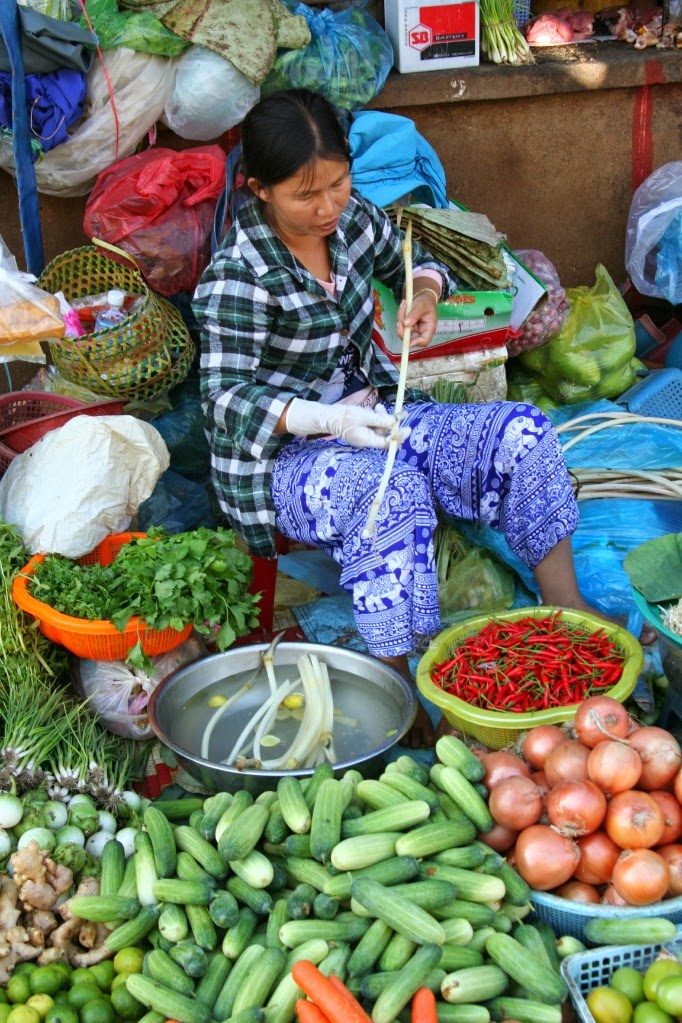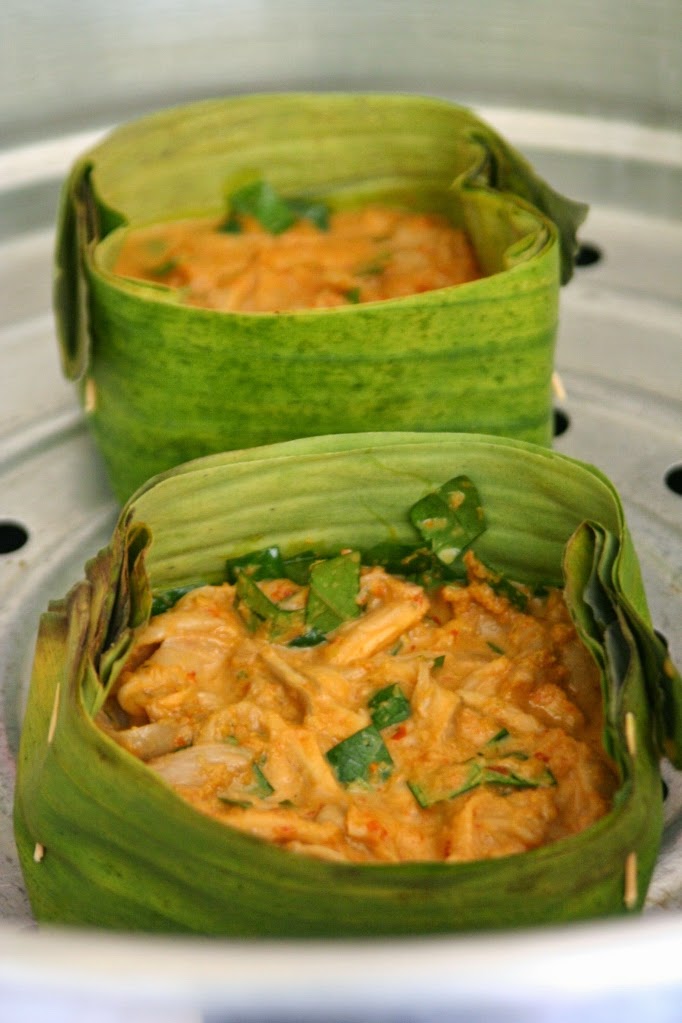The breakfast menu at our guesthouse seems to cater first and foremost to the appetite of the largely French-speaking guests, offering baguette and 'confiture', omelette and 'cheese', by which is meant 'la vache qui rit' dairy triangles. Actually the omelette and bread are rather good and were a step up on yesterday's pancakes.
Having checked out, we were met by the chef of a cooking school, with whom we had booked a lesson this morning. Lyly, a young Cambodian, is fresh out of Paul Dubrule's 'Ecole d'Hôtellerie et de Tourisme' in Siem Reap. Having done stints in hotels in Siem Reap and Sihanoukville, Lyly opened the Coconut House restaurant in his home town of Battambang, which he runs with his parents.
Our first job was to head to the market to pick up a few fresh items. While Lyly had already laid in many of the required ingredients for the four recipes we would be preparing, he was keen to show us the vegetables at Phsar Nat. Not being entirely 'green' when it comes to exotic produce, Lyly showed us some vegetables with which we were already familiar and some we didn't know. We can now distinguish morning glory for frying (green) and that intended for soups (reddish purple). He also gave us some unexpected warnings about frightening food combinations that we should avoid lest they cause a serious reaction. On the list of potentially fatal pairings are: durian and cola (no chance of that), mangosteen and sugar, black jelly and honey. Suitably chastened by these casual warnings, we collected the lemongrass and freshly squeezed coconut milk and returned to the restaurant.
It was a personal lesson with the chef, as only K and I had signed up for the morning session. Our first of four recipes, working in reverse order, was Lyly's signature dessert, a coconut panacotta. This was simple enough, with the chef putting in most of the work blending coconut flesh with fresh milk. I stirred the heated mixture until the sugar melted and K looked decorative. The mixture was poured into ramekins and went into the fridge to set.
Lyly accommodated our vegetarianism well and substituted ingredients in his usual recipes. Next up was that well-loved Khmer specialty, amok. With oyster mushrooms taking the place of the fish, we did most of the work on this dish. Excitingly, we took the traditional route of steaming the curry in banana leaf baskets. Lyly showed us how to fold these and pin them with cocktail sticks. While mine looked the part, filling it with the mixture revealed a structural weakness and it had to be replaced by the exemplar.
As to be expected, the equipment in the kitchen was top-knotch and we enjoyed razor-sharp knives and a heavy stone pestle and mortar with which to slice and pound the tough lemongrass into submission. The ingredients for the amok paste have become second-nature by now, but this included the lesser-spotted fingerroot (k'cheay) alongside the turmeric root, dried red chillies (for colour and flavour, not heat), kaffir lime leaves, shallots, garlic, and galangal ("never ginger!"). Lyly was exacting on the consistency of the paste, so we pounded until our arms ached and we feared the mortar would crack. We mixed the paste, coconut milk, palm sugar, and torn oyster mushrooms without heating and filled the banana leaf baskets. These were popped into a steamer for later. Beyond the key ingredients, Lyly told us that amok can be prepared in different ways, some variations containing eggs, others using peanuts (which make it heavier and more filling), some steamed, and others cooked solely in the pan (steaming takes longer and uses more gas, so it depends on the restaurant's commitment to quality cuisine).
Next on the menu was tofu lok lak. Typically prepared using beef, this dish is very similar to the Vietnamese bò lúc lắc (known as 'shaking beef'), where the name apparently derives from the cube-shaped pieces of beef. Accordingly, we fry and cube the tofu and stir it in a mix of tomato sauce, (not strictly vegetarian) oyster sauce, soy sauce, sugar, pepper, and garlic. Having fried this until sticky and pungent, it was served on a bed of lettuce, green tomatoes and thinly sliced onions, a lime-and-pepper dipping sauce, and topped with a fried egg.
The final dish was the appetiser, spring rolls - the fried, not fresh kind. These we had attempted in Vietnam, and the process was much the same here. We grated carrot and taro, creating a gluey substance that replaces egg as a binding agent, and sliced spring onion. Seasoning the mixture, we rolled small amounts into rice paper - the kind for frying, as the fresh paper contains water that causes much spluttering when in contact with hot oil.
Having 'plated up' under the watchful eye of Lyly, the feast was assembled. We tucked in amid much slurping and smacking of lips. The spring rolls, fresh from the fryer, were crispy and toothsome. The amok was light and delicate, while the lok lak was powerfully rich and peppery. Finishing off with Lyly's sweet creation, we rolled happily onto the bus back to Siem Reap.
Lyly's kitchen is spotlessly hygienic ("a clean chopping board helps me think"). He is meticulous in his preparation, enthusiastic and detailed in his explanation. From him, we not only learned Khmer recipes, but also gained fundamental chef skills and now know our chiffonade from our julienne. He speaks excellent English (also learnt at l'Ecole), helping him to convey his love for food, which is infectious.
On the bus, I fell into a gluttonous stupour and awoke only as we pulled into the bus station. Vowing not to eat again, we still managed to find room to snack on a few nibbles later in the evening. I dread to imagine what Lyly would think.







No comments:
Post a Comment